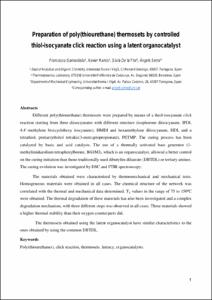Mostra el registre d'ítem simple
Preparation of poly(thiourethane) thermosets by controlled thiol-isocyanate click reaction using a latent organocatalyst
| dc.contributor.author | Gamardella, Francesco |
| dc.contributor.author | Ramis Juan, Xavier |
| dc.contributor.author | Flor López, Sílvia de la |
| dc.contributor.author | Serra Albet, Maria Àngels |
| dc.contributor.other | Universitat Politècnica de Catalunya. Departament de Màquines i Motors Tèrmics |
| dc.date.accessioned | 2019-02-04T12:56:48Z |
| dc.date.available | 2021-01-01T01:29:41Z |
| dc.date.issued | 2019-01-01 |
| dc.identifier.citation | Gamardella, F. [et al.]. Preparation of poly(thiourethane) thermosets by controlled thiol-isocyanate click reaction using a latent organocatalyst. "Reactive and functional polymers", 1 Gener 2019, vol. 134, núm. January, p. 174-182. |
| dc.identifier.issn | 1381-5148 |
| dc.identifier.uri | http://hdl.handle.net/2117/128308 |
| dc.description.abstract | Different poly(thiourethane) thermosets were prepared by means of a thiol-isocyanate click reaction starting from three diisocyanates with different structure (isophorone diisocyanate, IPDI, 4,4'-methylene bis(cyclohexy isocyanate), HMDI and hexamethylene diisocyanate, HDI, and a tetrathiol, pentaerythritol tetrakis(3-mercap- topropionate), PETMP. The curing process has been catalyzed by basic and acid catalysts. The use of a thermally activated base generator (1-methylimidazolium tetraphenylborate, BG1MI), which is an organocatalyst, allowed a better control on the curing initiation than those traditionally used dibutyltin dilaurate (DBTDL) or tertiary amines. The curing evolution was investigated by DSC and FTIR spectroscopy. The materials obtained were characterized by thermomechanical and mechanical tests. Homogeneous ma- terials were obtained in all cases. The chemical structure of the network was correlated with the thermal and mechanical data determined. T g values in the range of 75 to 150 °C were obtained. The thermal degradation of these materials has also been investigated and a complex degradation mechanism, with three different steps was observed in all cases. These materials showed a higher thermal stability than their oxygen counterparts did. The thermosets obtained using the latent organocatalyst have similar characteristics to the ones obtained by using the common DBTDL |
| dc.format.extent | 9 p. |
| dc.language.iso | eng |
| dc.rights | Attribution-NonCommercial-NoDerivs 3.0 Spain |
| dc.rights.uri | http://creativecommons.org/licenses/by-nc-nd/3.0/es/ |
| dc.subject | Àrees temàtiques de la UPC::Enginyeria dels materials::Materials plàstics i polímers |
| dc.subject | Àrees temàtiques de la UPC::Enginyeria química |
| dc.subject.lcsh | Catalysts |
| dc.subject.lcsh | Polymers |
| dc.subject.other | Poly(thiourethanes) |
| dc.subject.other | Click reaction |
| dc.subject.other | Thermosets |
| dc.subject.other | Latency Organocatalysts |
| dc.title | Preparation of poly(thiourethane) thermosets by controlled thiol-isocyanate click reaction using a latent organocatalyst |
| dc.type | Article |
| dc.subject.lemac | Catalitzadors |
| dc.subject.lemac | Polímers |
| dc.contributor.group | Universitat Politècnica de Catalunya. POLTEPO - Polímers Termoestables Epoxídics |
| dc.identifier.doi | 10.1016/j.reactfunctpolym.2018.11.019 |
| dc.relation.publisherversion | https://www.sciencedirect.com/science/article/pii/S1381514818308812 |
| dc.rights.access | Open Access |
| local.identifier.drac | 23617468 |
| dc.description.version | Postprint (author's final draft) |
| local.citation.author | Gamardella, F.; Ramis, X.; de la Flor, S.; Serra, M. À. |
| local.citation.publicationName | Reactive and functional polymers |
| local.citation.volume | 134 |
| local.citation.number | January |
| local.citation.startingPage | 174 |
| local.citation.endingPage | 182 |
Fitxers d'aquest items
Aquest ítem apareix a les col·leccions següents
-
Articles de revista [115]
-
Articles de revista [471]


